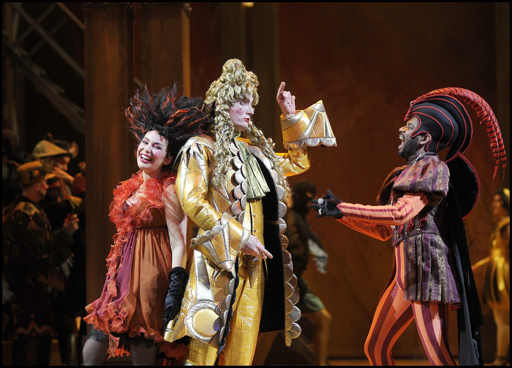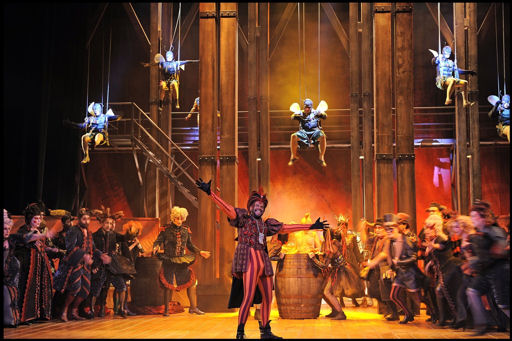Other Links
Editorial Board
- Editor - Bill Kenny
- London Editor-Melanie Eskenazi
- Founder - Len Mullenger
Google Site Search
SEEN
AND HEARD INTERNATIONAL OPERA REVIEW
Jacques Offenbach, Orphée aux enfers:
Soloists, chorus. ballet and orchestra of the Opéra National de
Montpellier, Languedoc-Rousillon, Hervé Niquet conductor.
Location, Montpellier, France. 23.12.2007 (MM)
Offenbach's vast catalogue is under-exploited here in the south of
France where the omnipresent Les Contes d'Hoffmann is
usually complimented by La Périchole and the Grande
Duchesse de Gérolstein. Happily this past holiday season,
Nice offered La Vie Parisienne and
Like Monteverdi's Orfeo who can move Hell only when he stops
trying to impress Hell, Offenbach's operettes become
deliciously amusing as they are meant to be, only when they are
not working at being funny, when Offenbach's simple parodies are
not themselves parodied. Orphée aux enfers in Montpellier
came in somewhere in the middle ground, sometimes simple and fun,
more often imploding upon itself from the sheer weight of
production and hyper-energized performances.

Gabrielle Philiponet as Eurydice, Marco de Sapia as Jupiter, Loïc
Félix as Pluto
Hoffmann
is never a problem - big music, big singers and big sets easily
impress. But that is that for easy Offenbach. La Périchole
and La Grande Duchesse are masterpieces of simple humanity
and simple humor, yet while suffering through overblown
performances of these complex and sophisticated slight and silly
pieces, one can only wonder what a Grand Duchess delivered by
Offenbach's legendary mezzo Hortense Schneider must have been
like, or savor memories of Stéphanie d'Oustrac's Périchole
in Marseille not so long ago, or Maria Ewing's Périchole in San
Francisco long, long ago. And one can only groan at recollections
of ponderous parody productions of Orphée aux enfers in
Santa Fe or La Belle Hélène in
Aix-en-Provence.

Offenbach made much of his genius for simple humanity and simple
humor in his early, small theaters; the original Orphée aux
enfers written in 1858 with two acts and four scenes for his
Théâtre des Bouffes Parisiens (a law had just been passed
that allowed more than four performers on its stage!). But
Offenbach, as so many of his producers since, succumbed to the
urge to elaborate on his successes by inaugurating his residency
in the big, new Théâtre de la Gaîté in 1874 with a style
énorme version, an orchestra of 60, a military band of 40, 120
choristers, 78 dancers, in 4 acts and 12 scenes. One can only
dream (or dread) that the Opéra Bastille will one day
produce this version.
The producers in Montpellier split the difference, coming up with
a version in two acts and four scenes which relied heavily on the
1858 version, adding material from the 1874 version. Whether
artistic or budgetary, the decision was a good one, offering an
afternoon that was finally amusing if not very
deliciously so. The success owes more to the staging of Claire
Servais (who inevitably had revised the text as well), than the
conducting of Montpellier's resident early music conductor Hervé
Niquet whose lugubrious-seeming tempos seldom ignited Offenbach's
mercuric score. But maybe that is about as fast as you can dance
the can-can anyway.
Claire Servais' staging relied heavily on sight gags of which
there were many, and a few good ones (Diana's dogs, Pluto's car,
John Styx' hand), a technique that draws attention to what is
supposed to be funny and obligates the performers to execute a
theatrical process rather than bring a role to life. The roles in
Orphée aux enfers are already compromised because they are
broad and bold caricatures, thus finding and projecting the je
ne sais quoi of
Much larger than Offenbach's Théâtre des Bouffes,
Montpellier's
Opéra Comédie (and the Opéra Royal de Wallonie and the Théatre
Municipal de Metz that share this production) beguiled the
producers into making the most of sets and costumes. Set designer
Dominique Pichou produced a fine Olympus, a perfect balance of
caricature with other worldly atmosphere, and enfers itself
was an appropriately functional space to show off the plentitude
of elaborate costumes designed by Jorge Jara. The lively can-can
of the corps de ballet, included Diana's four male hounds
now sporting colorful skirts which they waved in perfect unison
with those of seven ballerinas (some kicking higher than
others). The final chorus was repeated three or four times to the
great delight of a flock of Montpellians filled with holiday
spirit.
Michael Milenski
Pictures © Opéra National de Montpellier
